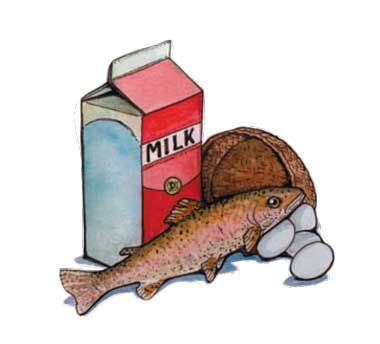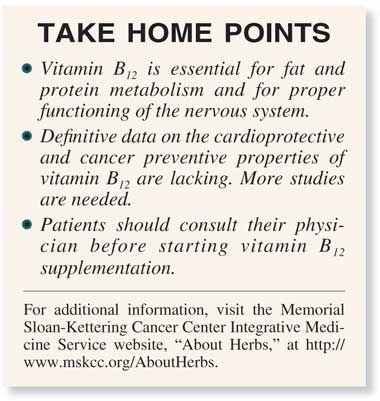Vitamin B12
Vitamin B12 is part of the vitamin B complex and is essential for maintaining nerve function, fatty acid metabolism, and DNA and amino acid synthesis. By lowering homocysteine levels, it may also protect against cardiovascular disease. Vitamin B12 can be obtained through diet (including eggs, dairy products, poultry, meat, and fortified cereals) and in supplement form. Deficiency of B12 can lead to a wide variety of hematologic, neurologic, and psychiatric disorders and may increase the risk of cardiovascular diseases. Clinical evidence to support the role of vitamin B12 in decreasing cancer risk is mixed. Further research is needed.
Vitamin B12 is part of the vitamin B complex and is essential for maintaining nerve function, fatty acid metabolism, and DNA and amino acid synthesis. By lowering homocysteine levels, it may also protect against cardiovascular disease. Vitamin B12 can be obtained through diet (including eggs, dairy products, poultry, meat, and fortified cereals) and in supplement form. Deficiency of B12 can lead to a wide variety of hematologic, neurologic, and psychiatric disorders and may increase the risk of cardiovascular diseases.
Clinical evidence to support the role of vitamin B12 in decreasing cancer risk is mixed. Further research is needed.
-Barrie Cassileth, PhD
ALSO KNOWN AS: Cyanocobalamin and cobalamin.
SUMMARY: Vitamin B12, a water-soluble vitamin, refers to the group of compounds that consists of cyanocobalamin and hydroxocobalamin. Vitamin B12 is essential for normal nerve function, DNA synthesis, hematopoiesis, fatty acid metabolism, and amino acid synthesis. It also plays an important role in the metabolism of homocysteine, high levels of which are associated with cardiovascular disease, and in the synthesis of S-adenosylmethionine, which regulates immune function and mood.

Vitamin B12 is abundant in eggs, dairy products, fish, shell fish, meat, poultry, and fortified cereals. It can also be obtained through supplements in the form of tablets, capsules, or softgels.
Vitamin B12 deficiency can lead to a wide variety of hematologic, neurologic, and psychiatric disorders and may increase the risk of cardiovascular diseases.[1] Low serum B12 levels have also been associated with increased bone turnover and fracture risk.[2]
Preliminary results indicate that supplementation with B12 and folate may play a role in reducing the toxicity of pemetrexed (Alimta), which is used to treat non–small-cell lung cancer.[4] Data also suggest an association of increased intake of vitamin B12, vitamin B6, and folate with reduced risk of breast[5] and cervical cancers;[6] however, no association was found between higher levels of these vitamins and risk of lung cancer.[7] Moreover, supplementation does not appear to affect the overall risk of invasive cancer.[8] Adding to the confusion, recent data indicate higher cancer incidence and mortality in patients with ischemic heart disease following supplementation with vitamin B12 and folic acid.[9] High levels of circulating B12 have also been associated with an increased risk of prostate cancer.[10]
More research is warranted to resolve these ambiguities and to determine the cancer preventive potential of vitamin B12.
ADVERSE REACTIONS: Although adverse effects are

rare with vitamin B12 intake, one case of rosacea fulminans was reported in a 17-year-old girl after consumption of high doses of vitamin B6 and vitamin B12 for 2 weeks.[11]
CONTRAINDICATIONS: Vitamin B12 may increase the risk of in-stent restenosis in patients after coronary stenting.[3]
DRUG INTERACTIONS: Medications that interfere with or suppress gastric acid and intrinsic factor production can lead to decreased vitamin B12 absorption.[1] Folic acid intake in amounts greater than the tolerable upper intake level may mask the symptoms of vitamin B12 deficiency.[12]
References:
REFERENCES
1. Oh R, Brown DL. Vitamin B12 deficiency. Am Fam Physician. 2003;67:979-86.
2. Dhonukshe-Rutten RA, Pluijm SM, de Groot LC, et al. Homocysteine and vitamin B12 status relate to bone turnover markers, broadband ultrasound attenuation, and fractures in healthy elderly people. J Bone Miner Res. 2005;20:921-9.
3. Lange H, Suryapranata H, De Luca G, et al. Folate therapy and in-stent restenosis after coronary stenting. N Engl J Med. 2004;350:2673-81.
4. Nakagawa K, Kudoh S, Matsui K, et al. A phase I study of pemetrexed (LY231514) supplemented with folate and vitamin B12 in Japanese patients with solid tumours. Br J Cancer. 2006;95:677-82.
5. Zhang SM, Willett WC, Selhub J, et al. Plasma folate, vitamin B6, vitamin B12, homocysteine, and risk of breast cancer. J Natl Cancer Inst. 2003;95:373-80.
6. Hernandez BY, McDuffie K, Wilkens LR, et al. Diet and premalignant lesions of the cervix: evidence of a protective role for folate, riboflavin, thiamin, and vitamin B12. Cancer Causes Control. 2003;14:859-70.
7. Hartman TJ, Woodson K, Stolzenberg-Solomon R, et al. Association of the B-vitamins pyridoxal 5'-phosphate (B(6)), B(12), and folate with lung cancer risk in older men. Am J Epidemiol. 2001;153:688-94.
8. Zhang SM, Cook NR, Albert CM, et al. Effect of combined folic acid, vitamin B6, and vitamin B12 on cancer risk in women: a randomized trial. JAMA. 2008;300:2012-21.
9. Ebbing M, Bonaa KH, Nygard O, et al. Cancer incidence and mortality after treatment with folic acid and vitamin B12. JAMA. 2009;302:2119-2126.
10. Collin SM, Metcalfe C, Refsum H, et al. Circulating folate, vitamin B12, homocysteine, vitamin B12 transport proteins, and risk of prostate cancer: a case-control study, systematic review, and meta-analysis. Cancer Epidemiol Biomarkers Prev. 2010;19:1632-42. Epub 2010 May 25.
11. Jansen T, Romiti R, Kreuter A, et al. Rosacea fulminans triggered by high-dose vitamins B6 and B12. J Eur Acad Dermatol Venereol. 2001;15:484-5.
12. Rampersaud GC, Kauwell GP, Bailey LB. Folate: a key to optimizing health and reducing disease risk in the elderly. J Am Coll Nutr. 2003;22:1-8.